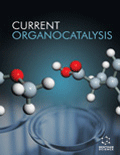- Home
- A-Z Publications
- Current Organocatalysis
- Previous Issues
- Volume 6, Issue 3, 2019
Current Organocatalysis - Volume 6, Issue 3, 2019
Volume 6, Issue 3, 2019
-
-
Recent Synthetic Methodologies for Chalcone Synthesis (2013-2018)
More LessAuthors: Saba Farooq and Zainab NgainiAn up-to-date short review of the chalcone methodologies is presented, which is the most interesting and beneficial for choosing the desired protocol to synthesize suitable derivatives of chalcones. Chalcones are fluorescent, stable compounds which contribute to the synthesis of various pharmacologically important heterocyclic structure-based derivatives. Chalcone has displayed a remarkable curative efficiency to cure s Read More
-
-
-
Functional Polysilanes and their Optical, Chiroptical and Photoluminescence Properties
More LessAuthors: Km. Meenu, Dibyendu S. Bag, Rekha Lagarkha, Radha Tomar and Arvind K. Gupta‘Polysilanes’ is an important class of inorganic polymers having Si-Si σ-conjugation along the backbone. They exhibit extraordinary electronic and photophysical properties and find suitable optoelectronics applications. They are typically synthesized by Wurtz coupling reaction of dichlorodialkylsilane or dichlorodiphenylsilane or dichloroalkylphenylsilane and their combinations under drastic reaction conditions by us Read More
-
-
-
Organophotoredox Catalysis: Visible-light-induced Multicomponent Synthesis of Chromeno[4, 3-b]chromene and Hexahydro-1H-xanthene Derivatives
More LessAuthors: Amit K. Sharma, Jyoti Tiwari, Deepali Jaiswal, Shailesh Singh, Jaya Singh and Jagdamba SinghBackground: In recent years, photoredox catalysis using eosin Y has gained considerable significance in organic chemistry. It is evolving as a powerful approach in modern organic synthesis for the activation of small molecules. Objective: The use of organic dyes to convert visible light into chemical energy by involving a single-electron transfer with organic substrates has innumerable applications. Method and Results: The p Read More
-
-
-
Ultrasonically Assisted Efficient and Green Protocol for the Synthesis of 4H-isoxazol-5-ones using Itaconic Acid as a Homogeneous and Reusable Organocatalyst
More LessAuthors: Sandeep B. Kasar and Shankar R. ThopateBackground: Multicomponent reactions involve the simultaneous reaction of three or more components which deliver the product that incorporates the elements of all starting materials. A combination of multicomponent reaction and green solvents like water and the use of nonconventional energy sources like microwave or ultrasonication are important features of ideal green synthesis. Therefore, the design of a new multic Read More
-
-
-
Recyclable Heterogeneous Fe-Mo Nanocatalyst: Application in Solvent Free Synthesis of β-enaminones
More LessBackground: In recent years, green organic transformation has become a challenge for a chemist in areas like social sector, health, and environment. Literature survey revealed that a nano magnetite supported heterogeneous catalysis is an emergent field with huge application in chemical synthesis. Objective: In the present article, the aim was to develop a simple and facile method to carry organic reaction under Read More
-
-
-
ZIF@ZnTiO3 Nanocomposite as a Reusable Organocatalyst for the Synthesis of 3, 4-dihydropyrano[c]chromene Derivatives
More LessAuthors: Taybeh Farahmand, Saeedeh Hashemian and Ali ShibaniBackground: Dihydropyrano [3, 2-c]chromenes and their derivatives have great attention for scientists. They have different activities such as biological properties, spasmolytic, diuretic, anticoagulant, anti-cancer, and anti-anaphylactic activity. For these vary biological activities, chromene derivatives have made significant for further progress in medicinal and organic synthesis studies. So, in view of the importance of chro Read More
-
-
-
Highly Efficient and Reusable Pd/AlO(OH) Catalyzed Synthesis of Acridinedione Derivatives
More LessAuthors: Benan Kilbas, Sinem Ergen and Davut CakiciBackground: Synthesis of acridinedione derivatives via one-pot multi-component approaches using highly active and reusable Pd/AlO(OH) heterogenous catalyst was studied. This process provided a convenient method to obtain various acridinediones with potential biological activities. The reactions were performed in mild conditions such as low temperature and short reaction time with desirable yields. Methods: Comm Read More
-
Most Read This Month
Article
content/journals/cocat
Journal
10
5
false
en

Most Cited Most Cited RSS feed
-
-
Liquid Membranes in Catalysis
Authors: Muhammad W. Ashraf and M. Amin Mir
-
- More Less

